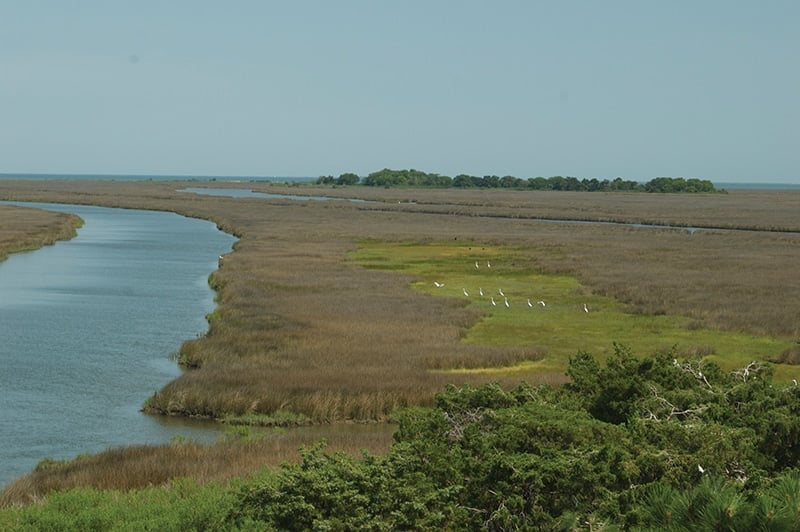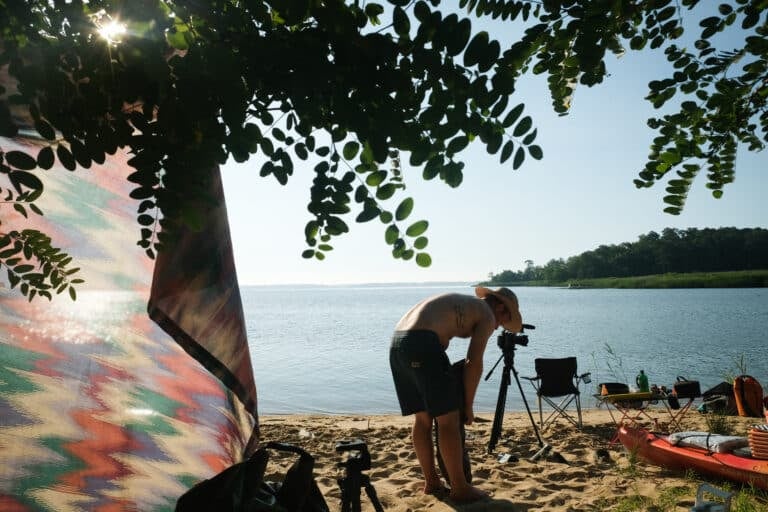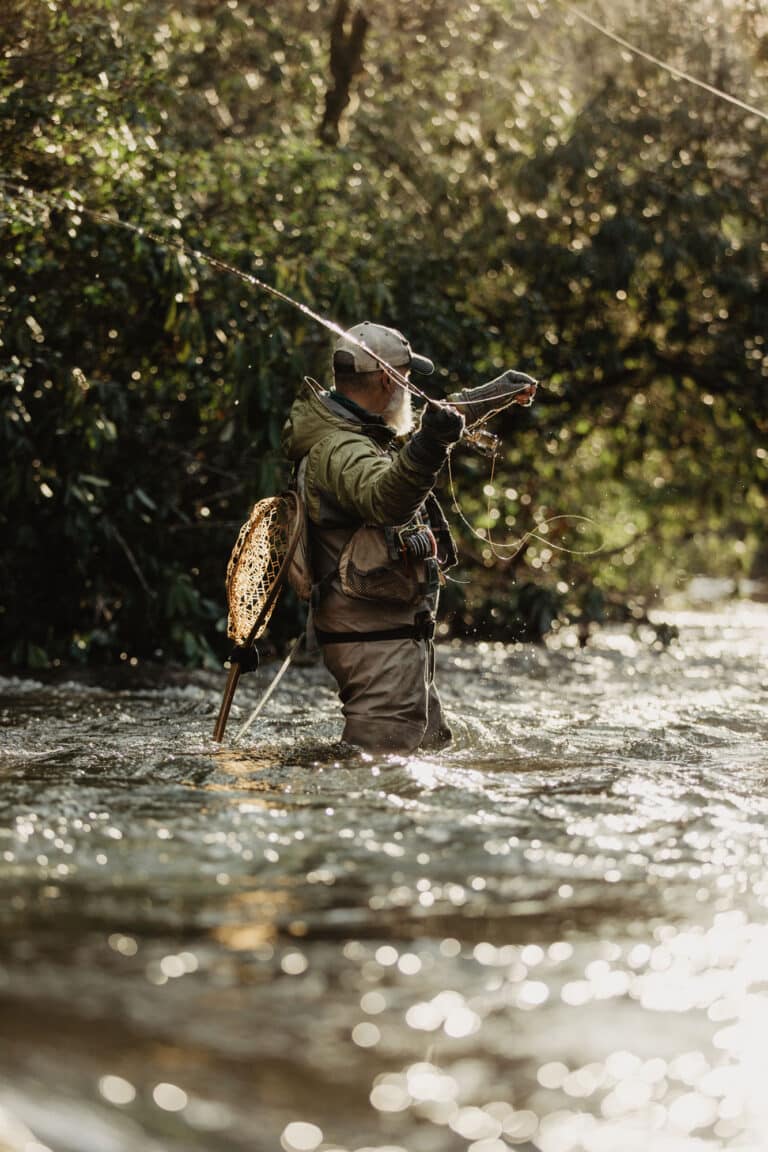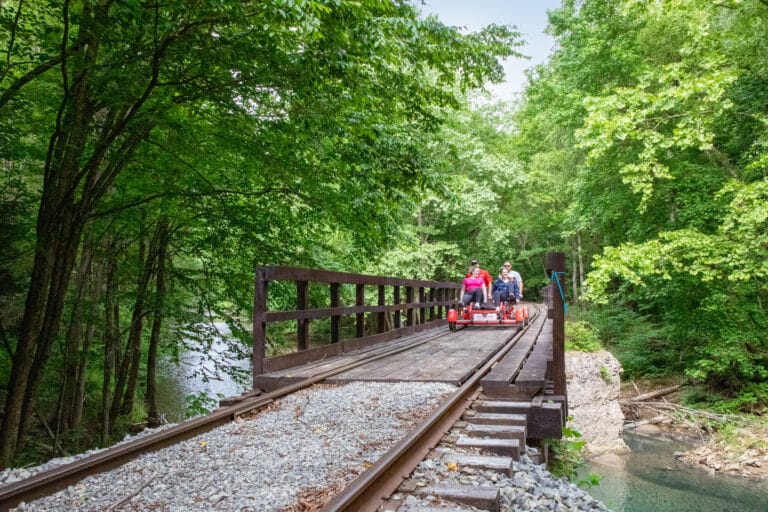The marshes at Blackwater NWR. Photo by Ray Paterra/USFWS
As climate change accelerates, conservation efforts at two of the Blue Ridge region’s key National Wildlife Refuges Becomes Increasingly important.
From the tidal wetlands of the Atlantic coast to high elevation spruce forests, National Wildlife Refuges (NWR) across the Mid-Atlantic and Southeast protect a variety of wildlife species and habitats vital to maintaining the biodiversity of our ecosystems. While other federal agencies manage land for various uses like historic features, recreation, timber, and water flows, refuges are maintained by the U.S. Fish and Wildlife Service specifically for the conservation of wildlife and their habitats.
“That’s a part of the mission of other federal agencies, but it’s not necessarily their primary purpose,” said Scott Schwenk, chief of the North Atlantic-Appalachian Division of Natural Resources and Conservation Planning for the USFWS.
From providing stepping stones for migrating waterfowl to helping recover threatened and endangered species, the more than 550 wildlife refuges across the country provide a sanctuary for wildlife. Each refuge is established with an expressed purpose outlined in law or executive order. “We would like the refuges to be nodes, center points, or hotspots of biodiversity that the surrounding landscape is connected to,” Schwenk said. “And then they can connect to each other across longer distances.”
Due to their fragile habitats and concerns for species preservation, not all parts of wildlife refuges are open to the public. Some especially sensitive refuges don’t allow public visitation at all. Matt Whitbeck, a wildlife biologist working in the Chesapeake Marshlands NWR Complex, said wildlife and habitat impacts are taken into account before opening them up to the public.
“The challenge is being able to walk that line in providing that recreational opportunity but doing it in a way that doesn’t interfere with our reason for existence,” he said. “It’s not like the whole refuge is open. Large parts of the refuge are undisturbed for the wildlife that use it truly as a refuge.”
Rapid Change at Blackwater
With refuges all along the coast, biologists and managers are concerned about the impact climate change will have on these ecosystems, including a direct loss of land as sea levels rise and land subsides. To see the effects of rising sea levels, Whitbeck points to what is happening at Maryland’s Blackwater National Wildlife Refuge.
“This really is the story of Blackwater,” he said. “Things are changing rapidly here. For a lot of people, the concept of sea level rise is something that is very theoretical. Something that maybe their children or grandchildren will have to deal with, but nothing that’s really impacting us now. You don’t have to be an ecologist to see the impacts of sea level rise here. A lot of these marshes along the Blackwater River have drowned and given way to open water. You can see areas of what we call ghost forest, areas where sea level rise has moved in and pushed marsh up into a forested habitat. The signature is all over the landscape here. This is something that’s not in the future. It’s not theoretical. It’s something that’s happening and happening now.”
An analysis of photos taken of the refuge in 1938 compared to photos taken in 2006 documented over 5,000 acres of tidal marsh converted to open water, the very marshes the refuge was established to protect.
“Tidal marshes are really important habitats,” Whitbeck said. “They are incredibly productive. It’s this transition zone, this world in between the uplands and the open water. There’s a whole suite of species that have really honed in on being able to not just exist, but thrive in this dynamic environment.”
In addition to the habitat they provide for a variety of species, this ecosystem also plays an important role in the surrounding communities. Wetlands provide a natural filter for our water supply, removing sediments and toxins caused by runoff. In times of flooding, wetlands also act as a natural sponge and help slow the speed of flood waters.
Before joining the National Wildlife Refuge Association as a regional representative, Mike Bryant worked for the Fish and Wildlife Service for more than three decades, overseeing refuges across the Southeast. “Climate change is the biggest existential challenge for refuges in the coastal plains,” he said. “It could increase the frequency of flooding. It would increase storm intensity, duration, and frequency. You could have big alterations from hurricanes causing forests to get knocked down.”
Even before there is a direct loss of land, a rising water table can alter the landscape. “If the water [level] is slowly rising, the water table is rising before the land goes underwater,” Bryant said. “The plant community can respond to that water table rising so where there was forest, in a relatively few number of decades, you can have a marsh.”
Analysis of those historical photographs also showed 3,000 acres of uplands converted to tidal marshes. The hardwoods and old-growth trees of the forests gave way to grasses and other marsh species that can survive in much wetter conditions.
“The same time sea level rise and land subsidence stresses the existing marsh, drowns the existing marsh, it is also sliding that tidal prism further up slope,” Whitbeck said. “It’s creating tidal wetlands where there were uplands.”
To help preserve this habitat for the future, refuge managers are looking at corridors where this marsh migration would be allowed to happen as sea levels continues to rise. “In order for the refuge to be successful, we don’t have to force the refuge back to what it used to look like,” Whitbeck said. “We don’t have to try to find millions and millions of dollars to restore marsh that was lost. That would be nice. We can think about where these marshes are being created through up slope migration and protect those lands from development and the creation of barriers that would impede that marsh migration, essentially work with that natural process.”
This means looking beyond the refuge and working with surrounding landowners for the future protection of wildlife and habitat.
“Wildlife doesn’t see boundaries, except by whether their habitat is there or isn’t,” Bryant said. “There’s a lot of opportunity in areas where these large refuges were established to create a network of lands working with partners. If you can get connectivity through private lands, conservation agreements, and state lands, you can end up getting this network of corridors so that over a long span of time, wildlife has a place to back up to. You’re trying to have a refuge system that has integrity in perpetuity for wildlife.”
In addition to losing marsh to sea level rise, biologists at Blackwater are also fighting invasive species that are taking over the landscape. Reducing the population of nutria, a large rodent native to temperate South America, is part of the plan to slow the conversion of marsh to open water in the refuge.
“The way they feed in this marsh is essentially like a rototiller going through the marsh,” Whitbeck said. “They feed on the roots and rhizomes of these marsh plants and they tear it up.”
Invasive species often outcompete native species for resources and space, threatening the quality of habitat and biodiversity on refuges. Phragmites, a common reed, is replacing native wetland grasses in the marsh.
“Once phragmites is in place, it’s not going anywhere,” Whitbeck said. “Phragmites marshes seem to be able to keep their head above water pretty well relative to sea level rise. Phragmites marsh is better than no marsh. But, from a wildlife perspective, it can be devastating for some species. If you’re a black rail or a salt marsh sparrow, there’s no habitat for you in these phragmites marshes. This is a riddle we’re still working on.”
Explore: Traverse the landscape of Blackwater on foot, bike, or paddle-powered boat for different views of the wildlife.
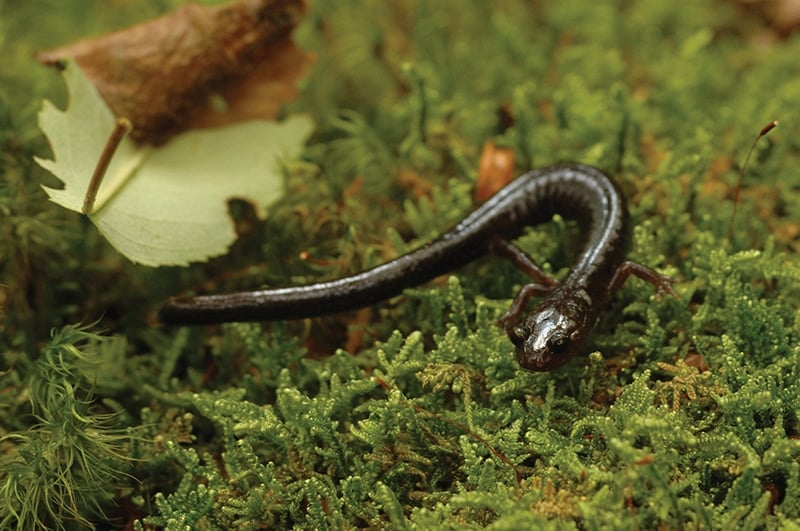
A Rare Ecosystem at Canaan
Managing for wildlife looks different on every refuge depending on what condition the habitat is in and if the landscape has been altered from its original form. At West Virginia’s Canaan Valley National Wildlife Refuge, you’ll find an ecosystem you don’t usually find in our region.
“The valley itself is the highest elevation valley east of the Mississippi River,” said Dawn Washington, a wildlife biologist at the refuge. “The habitats that you find in Canaan Valley’s wetlands and uplands are ones that you normally see in Canada, Maine, or New Hampshire. They’re very rare.”
The red spruce tree is found in the cool, moist climate conditions at high elevations. Because the soil in red spruce forests can store large amounts of water, this habitat can help ease the effects of flooding, drought, and fire on the landscape. Known for its lightweight, straight grain, and resiliency, the red spruce is highly prized for a number of products, including pulpwood, musical instruments, and lumber. In the late 1800s and early 1900s, loggers removed more than 90 percent of spruce forests in West Virginia, leading to drier conditions and an increase in wildfires on the landscape.
“This ecosystem is not a fire-dependent ecosystem, which means that it doesn’t depend on fire to grow,” Washington said. “Fire in this area is very uncommon. So, it really disturbed things.”
According to the Central Appalachian Spruce Restoration Initiative, of the more than 500,000 acres of red spruce forest that once covered West Virginia, an estimated 30,000 acres remain. Canaan Valley’s red spruce forest habitat is particularly important to refuge biologists as it supports several rare species they manage for.
The Cheat Mountain salamander, a threatened species found on only a few mountaintops in West Virginia, needs the cool, moist conditions in this environment as it breathes through its skin. The West Virginia northern flying squirrel, which was taken off of the endangered species list in 2013, uses cavities in the spruce trees for nesting. Although a recent report released by the USFWS determined “there is reason for optimism” about the future of the northern flying squirrel, there is still work to be done to restore and expand the red spruce forest.
Every spring, the refuge plants between 3,000 to 5,000 red spruce trees to help expand this habitat for the species that depend on it. In some areas, refuge managers prioritize this expansion by killing off hardwoods that dominate the canopy layer to speed up the release.
“In that ecosystem, hardwoods come in first,” Washington said. “Spruce will come in the understory, wait for its time for a canopy gap to open up, and it’ll take over that gap.”
At Canaan Valley, the future of climate change on the landscape is less certain. “In general, for a forest, there’s probably more time,” Scott Schwenk said. “We’re not expecting there to be rapid change in all of the tree species because they have such long generations. If you think of a tree that can live 50, 80, 100 years, a generation of a tree can be a really long time. Whereas the coastline, you can see sea levels rising every year.”
Refuges are using many of the same tools to they use to make wildlife populations more resilient as they prepare for climate change, such as restoring habitat and increasing connectivity.
“We know things are getting warmer,” Washington said. “It is changing our precipitation patterns. We’re getting stronger storms, heavier rains, and more flooding than we used to. Over the last couple of years, we haven’t seen as much snow in Canaan Valley. How is that going to impact things?”
Until more studies can be done at Canaan Valley to determine specific impacts, Washington said they are going to continue working to build up the red spruce habitats. “We’re investing so much time, energy, and money into red spruce because we have seen it be very resilient in the ecosystem it lives in,” she said. “Should we start planting species that live more south to anticipate that warming trend? We’re not ready for that. We’re not ready to give up and say the spruce is doomed here.”
Explore: Of Canaan’s 31 miles of roads and trails open for hiking, several also allow cross-country skiing, snowshoeing, biking, and horseback riding.
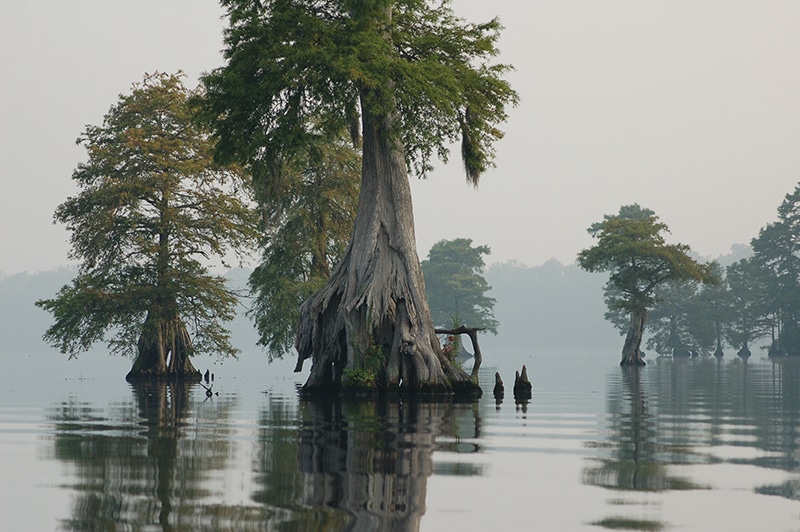
More Refuges: Experience the Wildlife
While wildlife and habitat impacts are considered before any recreation is allowed, wildlife refuges offer a great way to get outside and interact with an ecosystem. Plan a visit to one of these wildlife refuges in the region to learn more about the habitats and species they protect.
Carolina Sandhills, S.C.
Longleaf pines once covered about 90 million acres in the Southeast. Trails throughout the refuge take you through this declining ecosystem, in addition to wetlands and multiple lakes. There are more than 100 miles of sand and gravel roads open to cyclists.
Clarks River, Ky.
The bottomland hardwood forest of Clarks River acts as an “overflow swamp” area that helps mitigate damage caused by flooding. This ecosystem is home to more than 200 bird species. Visitors can view wildlife throughout the refuge and fish for crappie, sunfish, and catfish in the river and Environmental Education and Recreation Area with a permit. Kentucky will soon be getting its second refuge at Green River National Wildlife Refuge.
Piedmont, Ga.
The endangered red-cockaded Woodpecker is a native Southeastern bird that prefers the mature trees found in the refuge’s hardwood and pine forests. Explore the area by car on more than 50 miles of gravel roads or by foot with seven miles of hiking trails.
Tennessee, Tenn.
Located along the Tennessee River and Kentucky Lake, Tennessee National Wildlife Refuge is a major stop for migrating birds during the winter months, especially waterfowl. Hop on the water at one of the 23 boat ramps in the refuge to experience the wildlife and habitats.
Pee Dee, N.C.
From hawks and owls to Great Blue Herons and wood ducks, you will see a variety of bird species on the landscape depending on the time of year. In addition to hiking, cycling, and fishing, make sure to check out Gaddy Covered Bridge and Trail over Thoroughfare Creek.
Cherry Valley, Penn.
The federally threatened bog turtle calls the wetlands of Cherry Valley home. Although public access is located away from their sensitive habitats, you can hike or cross-country ski the trails to view other wildlife throughout the refuge.
Great Dismal Swamp, Va.
Scattered throughout the cypress and red maple forests and across Lake Drummond, birds, butterflies, and mammals find refuge in the Great Dismal Swamp. Get on the lake at several access points, hike more than 80 miles of trails, or take the Lake Drummond Wildlife Drive Auto Tour.
